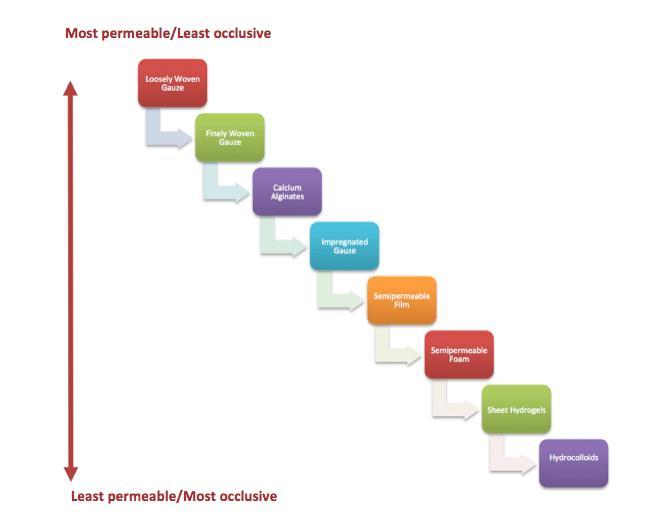The Continuum of Wound Dressings
Consider the following question:
How many wound management products are currently available on today’s market?
- a) 500
- b) 1000
- c) 2000
- d) more than 3000
If you answered d), you’re correct. There are more than 3000 wound care products available today. It can be very confusing and intimidating for practitioners new to wound care (and sometimes even for experienced wound care professionals) to choose the correct product to care for a client’s wound.
If you find yourself confused at times, you’re in good company. Boiled down to the simplest terms, there are eight categories of wound dressings, and all wound dressings will fit into one of these categories. Understanding the purpose and indications for each of these dressing categories can help you make the right decision for your patient. Essentially, dressings can be viewed on a continuum or absorptive or occlusive properties (see figure 1). Let’s start by looking at the simplest dressing available- the simple gauze dressing.
Gauze Dressings
Made from: woven or nonwoven gauze
Indications: Can be used or adapted for use on all wounds, no matter the size, depth or etiology, and may be used as a primary or secondary dressing; useful for wounds that require daily (or more frequent) changes due to low cost. May be used alone or in combination with another dressing, including foams, films or hydrogels. Gauze is often used to pack wounds to prevent premature closure and to absorb exudate.
Contraindications: Can cause trauma to the wound bed when gauze is removed, thus dressings should be moistened if they are adhered to the wound bed; may also leave fibers or residue behind, which could result in granuloma formation. Be careful not to make an inadvertent tourniquet when using roll gauze- this can be avoided by applying the gauze at an angle rather than wrapping straight across and avoiding tension on the roll. Gauze dressings may cause greater wound pain than other dressings.
The size of the pores in the gauze can make a difference in terms of absorption and permeability. Nonwoven gauzes are more absorbent than woven gauzes. Gauze with a loose weave will be more permeable to air, but will also trap wound debris within the large pores. This may be desirable if debridement is necessary, but may cause inadvertent injury to a newly granulating wound bed.
Over the next few weeks, we’ll look at the remaining seven dressing categories, including indications and contraindications. If you enjoy learning about wound management and are interested in becoming a certified wound consultant, visit Wound Educators to learn how to get started, or contact us.
Source:
Meyers, B (2008). Wound Management: Principles and Practice. 2nd edition. Pearson Prentice Hall. Upper Saddle River, New Jersey. pg. 128-130.


Hi. will like to know if you have an article of burns and recent treatment .I work in a trauma hospital. Thank you very much.